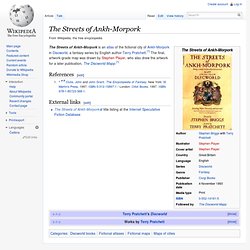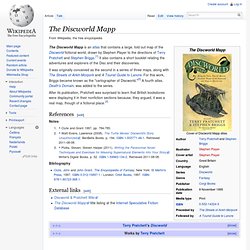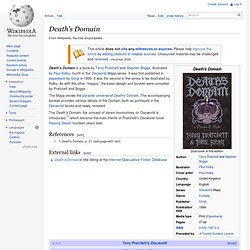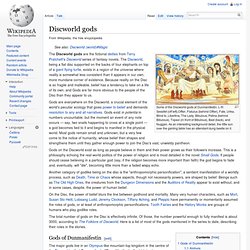

The Science of Discworld III: Darwin's Watch - Wikipedia, the fr. As with the first two volumes, the book alternates between a Discworld story and a serious scientific discussion.

The title refers to William Paley's watchmaker analogy and Richard Dawkins' subsequent description of evolution as the Blind Watchmaker. Plot summary[edit] The Streets of Ankh-Morpork. References[edit] External links[edit]

The Discworld Mapp. It was originally conceived as the second in a series of three maps, along with The Streets of Ankh-Morpork and A Tourist Guide to Lancre.

For this work, Briggs became known as the "cartographer of Discworld. "[2] A fourth atlas. Death's Domain, was added to the series. After its publication, Pratchett was surprised to learn that British bookstores were displaying it in their nonfiction sections because, they argued, it was a real map, though of a fictional place.[3] References[edit] Notes Bibliography External links[edit] Flora and fauna of the Discworld - Wikipedia, the free encyclope. Fauna[edit] Ambiguous Puzuma[edit] Basilisk[edit] A giant and nearly extinct snake, seen in Sourcery.

It has similar powers to a traditional basilisk, such as deadly venom and the ability to kill something by looking at it. When the basilisk in Sourcery met the Luggage, it attempted to stare the Luggage to death. Bookworm, .303[edit] Chimera[edit] The chimera is native to Klatch, but is a very rare species. The Science of Discworld. The purpose of the book is both to entertain and educate.

In having fictional sections in which observers from a very different world with a very different set of rules look with confused eyes upon the Earth ("Roundworld"), the authors are able to expand upon things we take for granted, such as planets being round and stars being far away, in a manner which is free of a line of thinking which states "But that's obvious". The cover of the book, designed by Paul Kidby, is a parody of the 1768 painting "An Experiment on a Bird in the Air Pump" by Joseph Wright of Derby. Plot summary[edit] The wizards create a series of balls of matter in space, and give one of them a Moon (accidentally). Other dimensions of the Discworld - Wikipedia, the free encyclop. Death's Domain[edit] Cover of the book.

Everything in his garden is a copy of something he has seen elsewhere, since Death cannot create. Things that stand out are a swing that he built from scratch, with his own hands, for Susan (with some distinct flaws in its design to allow it to actually 'swing'), the cats, which come and go into the Domain as they please and vary in colour (Death likes cats), and the wheat field created at the end of Reaper Man, which is golden, and ripples in the wind (despite the fact that there is no wind).
There are also distant mountains, and stars, neither of which belong to the Discworld. The Domain gardens also include a hedge maze and a golf course. To one side of the Domain is the Well of Souls, which spirits briefly pass through on their way to wherever they think they're going. A Tourist Guide to Lancre. Religions of the Discworld. Gods[edit] The Discworld, being a flat disc supported on the backs of four elephants on top of a giant flying turtle, exists in a region of the universe where reality is somewhat less consistent than it appears in our own, more mundane corner of existence.

Because reality on the Disc is so fragile and malleable, belief has a tendency to take on a life of its own, and Gods are far more obvious to the people of the Disc than they appear to us. Gods are everywhere on the Discworld, a crucial element of the world's peculiar ecology that gives power to belief and demands resolution to any and all narratives. Gods exist in potentia in numbers uncountable, but the moment an event of any note occurs — say, two snails happening to cross at a single point — a god becomes tied to it and begins to manifest in the physical world. Gods on the Discworld exist as long as people believe in them and their power grows as their followers increase.
Discworld. Wit and Wisdom of Discworld. Clacks. The technology depicted in Terry Pratchett's Discworld novels takes two forms: magical and mechanical.

Nearly all technology early in the series is at least partially magical, but in recent books there has been something of an industrial revolution, with numerous purely mechanical inventions being introduced. In Thud! Ancient 'devices' of undisclosed origin and great power were introduced; it is not clear whether these are magical, mechanical, both or neither. Death's Domain. The Mapp shows the parasite universe of Death's Domain.

The accompanying booklet provides various details of the Domain, both as portrayed in the Discworld books and newly revealed. The Death's Domain, the concept of steam locomotives on Discworld is introduced,[1] which became the main theme of Pratchett's Discworld novel Raising Steam fourteen years later. References[edit] Jump up ^ Death's Domain, p. 21 (last page with text) External links[edit] Death's Domain title listing at the Internet Speculative Fiction Database. Discworld geography. Discworld (world) Discworld gods. Some of the Discworld gods at Dunmanifestin.

L-R: Sessifet (off left),Offler, Flatulus (behind Offler), Fate, Urika, Blind Io, Libertina, The Lady, Bibulous, Patina (behind Bibulous), Topaxi (in front of Bibulous), Bast (back), and Nuggan. As an interesting background detail, the little sun over the gaming table has an attendant dung beetle on it. Gods on the Discworld exist as long as people believe in them and their power grows as their followers increase. This is a philosophy echoing the real-world politics of the power of religion and is most detailed in the novel Small Gods. If people should cease believing in a particular god (say, if the religion becomes more important than faith) the god begins to fade and, eventually, will "die", becoming little more than a faded wispy echo.
Ankh-Morpork. Tallinn, one of the real-life prototypes of Ankh-Morpork In The Art of Discworld Pratchett explains that the city is similar to Tallinn and central Prague, but adds that it has elements of 18th century London, 19th century Seattle and modern New York City. He also states that since the creation of The Streets of Ankh-Morpork, he has tried to ensure that the descriptions of character movements and locations in the books match the Ankh-Morpork map; this has allowed him, and fans of the series, to visualise the story more clearly.
Ankh-Morpork is also referred to as "The Great [or Big] Wahoonie" on occasions, alluding to "The Great Wen" (London), or to "The Big Apple" (New York). It is stated in the novel 'Moving Pictures' that "There's a saying that all roads lead to Ankh-Morpork. And it's wrong. Geography[edit] Technology of the Discworld. The technology depicted in Terry Pratchett's Discworld novels takes two forms: magical and mechanical. Nearly all technology early in the series is at least partially magical, but in recent books there has been something of an industrial revolution, with numerous purely mechanical inventions being introduced. In Thud! Ancient 'devices' of undisclosed origin and great power were introduced; it is not clear whether these are magical, mechanical, both or neither. The History Monks also have their own technology, the exact nature of which is usually unclear.
Most Discworld technologies have real-world equivalents, in function if not form. Technological development[edit] The Science of Discworld II: The Globe - Wikipedia, the free enc. The book alternates between a typically absurd Discworld story and serious scientific exposition. The Folklore of Discworld. The Art of Discworld. The Discworld Companion. The Unseen University Challenge - Wikipedia, the free encycloped. The Unseen University Challenge is a book of trivia questions related to Terry Pratchett's Discworld novels.
It was written by David Langford (with Terry Pratchett's permission) and was published in 1996. Its name is a reference to the television quiz University Challenge. Nanny Ogg's Cookbook. Nanny Ogg's Cookbook is a recipe book written from the in-world perspective of Discworld character Nanny Ogg. Nanny Ogg's Cookbook was written by Terry Pratchett, Stephen Briggs and Tina Hannan, and illustrated by Paul Kidby. The Discworld Almanak.